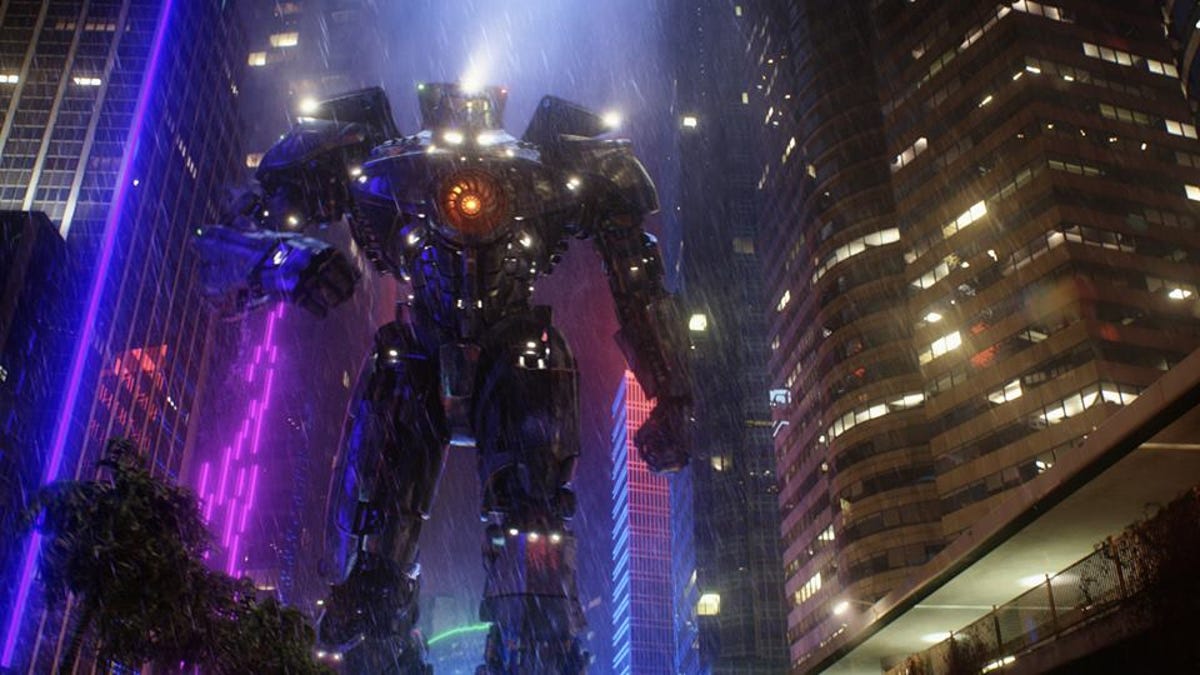Is 'Pacific Rim' a retelling of Japanese anime 'Evangelion'?
While there are strong similarities between the two mecha-versus-monster tales, Guillermo del Toro's stunning visual roller-coaster goes in its own direction.

The scene: Tokyo lies in ruins. A child is alone in the wreckage and terrified as a colossal monster approaches. The creature's on an unstoppable rampage and the kid's fate looks sealed. Until a savior steps in at the last moment.
Fast forward: The kid is introduced to an international military program that builds giant robotic machines to fight marauding alien monsters. But the machines must be piloted by people with special neurological abilities. Naturally the kid has this power, and is chosen to mount humanity's last defense against the invasion.
If you saw "Pacific Rim" over the weekend, you know this story. But it feels very familiar if you've also seen "Neon Genesis Evangelion," the blockbuster 1995-1996 anime series that redefined the giant robot sci-fi genre in Japan. What does Guillermo del Toro's big budget sci-fi slugfest owe to that franchise?
In Japan, "Evangelion" is an enormous content and merchandise industry with hundreds of millions of dollars in revenue. Images of its biomechanical Eva robots are on everything from coffee mugs to smartphones and even airplane wraps. It's the story of teenager Shinji Ikari, who gets recruited by an organization called NERV to become an Eva pilot and fight off the invading monsters, called Angels.
"Pacific Rim" is of course derivative of many Japanese franchises, from "Godzilla" and "Ultraman" to "Mazinger Z" and "Gundam," that feature mecha (machines) or kaiju (monsters). But when I saw it the other day, I walked away feeling that it reflects animator Hideki Anno's tale to a striking degree.
Both feature love-struck characters who enter and pilot giant machines in a global war against alien monsters, waging epic battles in dense urban areas and on the high seas.
The pilots are immersed in an amniotic fluid-type liquid to achieve a psychic link with their machines, which get transported to battle by a fleet of aircraft. The main characters are haunted by psychological trauma that initially prevents them from beating the monsters. Check out the fan vid below for a comparison of scenes.
Most of the Jaegers, as the giant robots in "Pacific Rim" are called, look a lot more like the bulky, samurai-style mecha of "Gundam" than the svelte, biomechanical Evas; pilots Raleigh Becket (Charlie Hunnam) and Mako Mori (Rinko Kikuchi) also wield a giant sword with their mecha Gipsy Danger, another Gundam echo.
Shock-and-awe homage
But where "Evangelion" and its 1997 film "The End of Evangelion" are convoluted existential psycho-dramas wrapped in a "Power Rangers"/"Super Sentai" format and peppered with Christian symbolism and father-son drama, "Pacific Rim" is really a shock-and-awe homage to mechas and man-in-the-rubber-suit monsters. It doesn't ask for your brain to participate.
Filmed in Toronto, where part of Elizabeth Street behind Toronto City Hall was transformed to look like Tokyo, "Pacific Rim" devotes lavish attention to visual detail. It features spectacularly designed mecha, gripping monster combat scenes, and settings that evoke Alaska, Hong Kong, and Japan.
"I felt there was a chance to do something fresh, something new that at the same time was conscious of the heritage, but not a pastiche or an homage or a greatest hits of everything," Del Toro told the LA Times last year. "One of the first things I did is make it a point to not check any old movies or any other references. Like start from scratch."
Strong cyberpunk aesthetic
"I did love Evangelion very much, but I actually wrote most of Pacific Rim before I saw it," fellow screenwriter Travis Beacham said on Twitter.
While some "Evangelion" fans might take issue with the similarities between the two, ultimately "Pacific Rim" comes off as its own film despite the abundance of ideas it draws from the genre. It's far more fascinated with kaiju and their gooey anatomy, it emphasizes a "Top Gun"-style pilot rivalry, and it's got a strong cyberpunk aesthetic. It references "Blade Runner" in one subplot, apart from dozens of other franchises that are in the story's DNA.
"Pacific Rim" has yet to open in Japan, but early otaku assessment seems positive. Metal Gear video game creator Hideo Kojima positively gushed over it on Twitter, even suggesting it's unpatriotic not to love it. After all, it does have some of the coolest giant robots ever seen onscreen.
Pacific Rim is the ultimate otaku film that all of us had always been waiting for. Who are you, if you are Japanese and won't watch this?
— HIDEO_KOJIMA (@HIDEO_KOJIMA_EN) July 5, 2013

